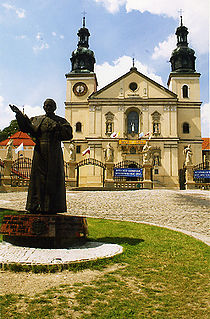Kalwaria Zebrzydowska park
| Kalwaria Zebrzydowska: the Mannerist Architectural and Park Landscape Complex and Pilgrimage Park |
|
|---|---|
| Name as inscribed on the World Heritage List | |
 |
|
| Location | Poland |
| Type | Cultural |
| Criteria | ii, iv |
| Reference | 905 |
| UNESCO region | Europe and North America |
| Inscription history | |
| Inscription | 1999 (23rd Session) |
Kalwaria Zebrzydowska park is a Mannerist architectural and park landscape complex and pilgrimage park, built in the 17th century as the Counter Reformation in the late 16th century led to prosperity in the creation of Calvaries in Catholic Europe.
The park, located near the town of Kalwaria Zebrzydowska, which took its name from the park, was added in 1999 to the UNESCO list of World Heritage Sites. The site is also one of Poland's official national Historic Monuments (Pomnik historii), as designated November 17, 2000 and tracked by the National Heritage Board of Poland.
Kalwaria Zebrzydowska was established in 1600 by Mikołaj Zebrzydowski, voivode of Kraków for Franciscan monks (custodians of the Holy Sepulchre in Jerusalem). It was modelled on the 1584 map of Jerusalem by Christian Kruik van Adrichem.
Monastery
Interior of the Church
Ecce Homo Chapel
Courtyard
Coordinates: 49°52′N 19°41′E / 49.867°N 19.683°E
...
Wikipedia
